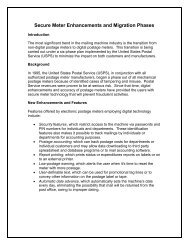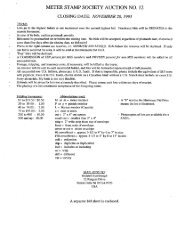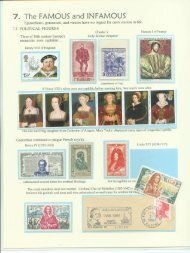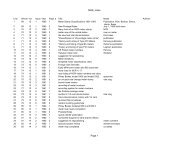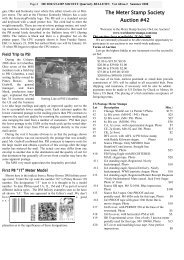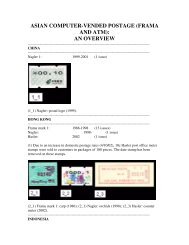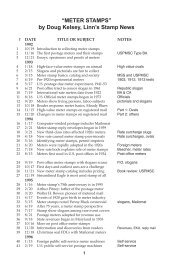GB Meter Franking - The Meter Stamp Society
GB Meter Franking - The Meter Stamp Society
GB Meter Franking - The Meter Stamp Society
Create successful ePaper yourself
Turn your PDF publications into a flip-book with our unique Google optimized e-Paper software.
BRITISH STAMPS<br />
<strong>GB</strong> <strong>Meter</strong> <strong>Franking</strong><br />
Part 6—Postwar to Decimalisation<br />
Continuing his history of meter franking, Jack Peach looks back at the<br />
postwar period, with new machines, new frank designs, and company<br />
amalgamations<br />
Peacetime and shortages<br />
<strong>The</strong> last article brought our story to the end of the 1939-45 war. <strong>The</strong> factories of the<br />
meter machine manufacturers had been primarily engaged in making armaments rather<br />
than cancelling and franking machines. Since 1936 the UPF factory had been in Cannon<br />
Street, Islington, but by 1946 the lease was due to expire. New premises were found at<br />
Edmonton but the ‘fuel crisis’ during the winter of 1946-47 and general shortages of<br />
materials did not help the transfer. <strong>The</strong> company gained priority support from the Post<br />
Office and the Board of Trade so that by the end of 1947 the move had been completed.<br />
UPF had used the telegraphic code In 1931 Roneo-Neopost had been registered<br />
and the production of the Neopost<br />
word ‘Francopost’ for some years so, with a<br />
slight change of spelling, the Edmonton machine transferred to the Roneo factory<br />
factory became the Frankopost Works. <strong>The</strong> in Romford, where the modern machines<br />
name Universal Postal Frankers was a bit of are still made today.<br />
a mouthful for everyday use so the word During the war Roneo, like others, were<br />
‘Frankopost’ was used in connection with concerned with armament production.<br />
all UPF products. It also made a better When the war ended they were faced with<br />
comparison with ‘Neopost’!<br />
similar problems in getting back to franking<br />
machine manufacture as were UPF. At<br />
During this immediate postwar period<br />
Frank Parfett (in charge of UPF machine Romford, however, priority was given to<br />
development) spent time restyling the making Roneo duplicators; franking machines<br />
had to take a back seat. Little or no<br />
Midget which had remained virtually unchanged<br />
since its introduction 20 years development took place. <strong>The</strong> Neopost<br />
previously. Frank Parfett, incidentally, had<br />
been concerned with franking machine<br />
design since he joined Frank Langdon at<br />
UPF to develop their first NZ model in<br />
1922. Langdon had left UPF in 1934 to<br />
form his own company, Langdon Precision<br />
Engineers Ltd, to develop and manufacture<br />
industrial machine tools in his factory<br />
in Battersea. It will be recalled that Langdon<br />
had been responsible for the development<br />
of the first Neopost machine with<br />
Kinnard in 1927.<br />
Fig 105 (below) Frankopost Simplex<br />
Fig 106 (bottom right) Mark made by the<br />
Frankopost Simplex<br />
Fig 107 (right) Cover franked by the<br />
Frankopost Multivalue machine of the<br />
Post Office Foreign Section<br />
range had remained unchanged since the<br />
introduction of the Limited Value machine<br />
in 1930. It was clear that a multivalue machine<br />
was much needed. As a matter of<br />
fact, Roneo had designed a prototype before<br />
the war but it proved too costly to<br />
produce and was generally unacceptable.<br />
Roneo-Neopost approached Frank Langdon<br />
and he agreed to undertake a design.<br />
As the production of franking machines<br />
increased it became necessary to extend<br />
the prefixes of more popular machines.<br />
<strong>The</strong> ‘UA’ for the UPF Multivalue was followed<br />
by ‘UB’, ‘UC’ to ‘UF’ in George VI’s<br />
reign and to ‘UK’ in later years. <strong>The</strong> Pitney<br />
Bowes Model CV followed the prefix ‘P’<br />
with ‘PA’ and ‘PC’ later (‘PB’ was already<br />
being used on Single Value machines).<br />
<strong>The</strong> restyling of the Midget machine was<br />
completed and launched as the Frankopost<br />
Simplex with the prefix letter ‘S’ and<br />
later by ‘SA’.<br />
22 G.S.M. October 2001
BRITISH STAMPS<br />
Fig 108 Ticket Issue Machines Ltd<br />
Cambridge trial mark<br />
Fig 109 Westinghouse-Garrard Ticket<br />
Machines Ltd used by British Rail<br />
Fig 110 Frankopost Simplex trial on tape<br />
from a roll<br />
Fig 111 An example from the Parcel-<br />
Label Printing and Issuing Machine No 2<br />
Fig 112 Frank from the Festival of Britain<br />
Branch Office TIM machine<br />
Fig 113 Specimen examples from the<br />
British Industries TIM machine. <strong>The</strong><br />
machine printed its mark in two<br />
operations and the lower example has<br />
part missing<br />
Fig 105 illustrates the machine and Fig<br />
106 the mark made. <strong>The</strong> Simplex machine<br />
was of the Limited Value type with a range<br />
of 13 values from 1 ⁄2d. to 6 1 ⁄2d. This was the<br />
only new machine introduced during the<br />
reign of King George VI.<br />
In the last article some uses of franking<br />
machines by the Post Office were described.<br />
Another use was by the Foreign Section,<br />
mainly on Post Office mail to countries<br />
abroad. As far as is known, only one machine<br />
was used, a Frankopost Multivalue<br />
machine number UB 52. <strong>The</strong> town mark<br />
was London/FS. An example with the<br />
added handstamp ‘On Postal Service’ is<br />
shown in Fig 107 on a cover from GPO HQ<br />
to Belgium.<br />
Parcel post<br />
Parcels sent through the post attracted a<br />
large number of rates and in most cases<br />
more than one adhesive stamp had to be<br />
applied. This meant much ‘licking and<br />
sticking’! By 1947 several machines had<br />
been developed which could print money<br />
values on to paper tape held in roll form<br />
and from which short lengths could be<br />
readily separated after receiving a printed<br />
value. <strong>The</strong>se machines had been largely<br />
developed to provide receipts for fares on<br />
buses and trams. <strong>The</strong> Post Office saw their<br />
potential for use at post office counters to<br />
produce postage paid labels, gummed on<br />
one side, for fixing on parcels.<br />
<strong>The</strong> first trials took place at Romford and<br />
Cambridge between April and September<br />
1947. <strong>The</strong> two Limited Value machines<br />
were made by Ticket Issue Machines Ltd<br />
(TIM). <strong>The</strong> 12 values ranged from 6d. to<br />
1s.5d. in steps of 1d. Fig 108 illustrates the<br />
mark made by the Cambridge trial machine.<br />
<strong>The</strong> example is clearly dated 20 AP<br />
47, although the official date for it being<br />
brought into use was 28 April 1947.<br />
<strong>The</strong> trials were considered successful<br />
and the Post Office ordered 100 machines<br />
which they called ‘Parcel Label Machine<br />
No 1’. <strong>The</strong> main difference in the mark<br />
made by the production machines was the<br />
wording ‘PARCEL POST/PAID’ instead of<br />
‘PARCEL POST’. <strong>The</strong>y came into use in<br />
1948.<br />
<strong>The</strong> second type of machine to be tested<br />
was made by Westinghouse-Garrard Ticket<br />
Machines Ltd. Again, the test was undertaken<br />
at Cambridge between 12 December<br />
1947 and 2 November 1948. A further<br />
trial was carried out at Birmingham between<br />
14 February 1949 and September<br />
1950. No orders were placed but similar<br />
machines were later used by British Rail<br />
(Fig 109).<br />
In September 1950 two Frankopost<br />
Simplex machines were modified to print<br />
on tape from a roll. <strong>The</strong>se were placed for<br />
trial at Romford and Birmingham, respectively.<br />
An example from Birmingham is<br />
illustrated (Fig110). Again, no orders were<br />
placed.<br />
<strong>The</strong> last of the series of trials was undertaken<br />
on two machines made by Setright<br />
Registers Ltd in October 1951, installed at<br />
Birmingham and Cambridge. <strong>The</strong>y were<br />
Limited Value-type machines and no orders<br />
were placed at that time.<br />
Arising from the experience gained in<br />
these various tests, a specification was prepared<br />
for a two-bank Multivalue-type machine.<br />
In the event, an order for 600 machines<br />
was placed with Setright Registers.<br />
<strong>The</strong>y were capable of printing any value<br />
between 1d. and 19s.11d. (in steps of 1d.).<br />
Known as the Parcel-Label Printing and<br />
Issuing Machine No 2, they came into use<br />
in 1959. An example is shown (Fig 111).<br />
One of these machines is in the Heritage<br />
Collections at the Post Office, arranged to<br />
print Specimen examples.<br />
A TIM machine was installed at the<br />
Festival of Britain Branch Office in 1951.<br />
Only 2000 labels were printed (only 73<br />
went on to actual parcels!) so they are not<br />
very common (Fig 112).<br />
<strong>The</strong> TIM machine printed its mark in<br />
two operations as shown by the Specimen<br />
examples from a machine at the British<br />
Industries Fair (Fig 113—on one the lefthand<br />
part of the mark has been omitted).<br />
By 1960 only Setright machines were in<br />
use.<br />
New reign, new frank<br />
King George VI died on 6 February 1952<br />
and was succeeded by his elder daughter,<br />
Elizabeth—Queen Elizabeth II. <strong>The</strong> general<br />
style of franks remained the same but<br />
the cypher was changed to EIIR, there was<br />
also a change to the shape of the crown.<br />
<strong>The</strong>se franks are known by collectors as<br />
group E.<br />
Pitney Bowes Single Value and Model<br />
CV meters, UPF NZ, Midget and Simplex<br />
machines and Neopost Fixed Value and<br />
Limited Value machines all changed to the<br />
new style of frank in 1953. Only three NZ<br />
machines (numbered NZ 13, NZ 16 and<br />
NZ 170) were still in use and no Pitney<br />
Bowes Model H machines changed.<br />
In 1953 UPF (Frankopost) introduced<br />
a Simplex machine capable of printing<br />
25 different values. This was called the<br />
‘Major’ model and values ranged from 1 ⁄2d.<br />
to 1s. 1 ⁄2d. <strong>The</strong> original 13-value machine<br />
( 1 ⁄2d. to 6 1 ⁄2d.) was called the ‘Junior’ model.<br />
SA and SB prefixes were used with Junior<br />
machines. <strong>The</strong> Simplex Major was more<br />
popular and prefixes ran from SX to SZ,<br />
then backwards SW to SV; SV being<br />
reserved for Junior models converted to<br />
Major. One machine, SZ 638, used by<br />
G.S.M. October 2001 23
BRITISH STAMPS<br />
Fig 114 (top) Label from the modified Simplex Major machine of Draffens of<br />
Dundee<br />
Fig 115 (above) Specimen label from Draffens’ second machine, numbered<br />
SL2, on tape intended for the multivalue machine<br />
Fig 116 (below) A label anticipating foreign sales of the Simplex<br />
MacRobertson & Hutchinson of Glasgow,<br />
was issued posthumously with a George VI<br />
Group D frank die.<br />
Although the normal Simplex machines<br />
could not print on to continuous paper<br />
tape, it has been mentioned that two<br />
machines were modified for the Post Office<br />
to produce parcel post labels. In 1955 a<br />
similarly modified Major model was sold<br />
to Draffens of Dundee Ltd. <strong>The</strong> values<br />
printed ranged from 1d. to 2s.1d. in steps<br />
of 1d. <strong>The</strong> prefix SL was allocated to this<br />
model.<br />
Fig 114 shows labels for this machine,<br />
numbered SL1. Initially, ‘SL1 DUNDEE<br />
ANGUS’ was printed continuously along<br />
the tape. Later, when the company acquired<br />
a second machine, the wording was<br />
changed to ‘DRAFFENS OF DUNDEE<br />
LTD. ANGUS’. <strong>The</strong> second machine,<br />
numbered SL2, was supplied in 1956. This<br />
was a Junior model with values from 1 ⁄2d. to<br />
1s. 1 ⁄2d. Some specimens from this machine<br />
were printed on tape intended for the<br />
multivalue machine UF 490 (Fig 115), later<br />
the normal DRAFFEN tape was used. Only<br />
two machines were sold in the UK but<br />
foreign sales were at least anticipated, as<br />
illustrated in Fig 116 for use in Singapore.<br />
By 1955 Langdon had developed a multivalue<br />
machine for Neopost. It was given<br />
the name ‘Frankmaster’ and the earliest<br />
model was available for commercial use<br />
in that year. <strong>The</strong> electrically-driven<br />
version is illustrated (Fig 117). As<br />
introduced, the machine was heavy<br />
and awkward to handle, bearing in<br />
mind that it had to be taken to a local<br />
post office for resetting. <strong>The</strong> features<br />
offered were the basic minimum.<br />
Nevertheless, it filled a major gap in<br />
the Neopost range. Development<br />
continued and a redesigned version<br />
called the Model 305 was launched<br />
in 1965. During the ‘E’ frank period,<br />
prefixes used were NA to ND. For each<br />
prefix, machine numbers ranged from 001<br />
to 999. <strong>The</strong>re were several versions of the<br />
Neopost 305 with either 3 or 4 operable<br />
banks. From the right of the frank, the first<br />
bank printed either ‘ 1 ⁄2’ or ‘=’, the second<br />
bank printed ‘=’ for the nil value, then ‘1’<br />
to ‘11’ (‘10’ and ‘11’ were printed as if<br />
single characters). <strong>The</strong> third bank used ‘0’<br />
for the nil value, then printed ‘1’ to ‘9’.<br />
<strong>The</strong> fourth bank again used ‘=’ as the nil<br />
value, then printed ‘1’ to ‘9’. Fig 118 shows<br />
how ‘2d.’ appeared. Fig 119 is a specimen,<br />
illustrating the maximum possible value<br />
from a four-bank machine and shows ‘11’<br />
as a single character. Fig 120 shows a frank<br />
on a piece of continuous tape.<br />
As with the Simplex, one machine,<br />
numbered NA 156, used by James H<br />
Lamont of Edinburgh, was fitted with a G<br />
VI R Group D die posthumously. It would<br />
appear that the machine was originally<br />
supplied with an EIIR die. It has been<br />
suggested that the user requested a G VI R<br />
die for patriotic reasons!<br />
At Universal Postal Frankers their design<br />
team had been commissioned to redesign<br />
the multivalue machine. <strong>The</strong> new version<br />
was launched in 1958 with the name<br />
‘Automax’.<br />
Three-bank machines had the value<br />
range 1 ⁄2d. to 9s.11 1 ⁄2d. and four-bank either<br />
1<br />
⁄2d. to 29s.11 1 ⁄2d. or 1 ⁄2d. to 99s.11 1 ⁄2d.<br />
Hand-driven models could print up to<br />
40 items/minute and electrically-driven<br />
models up to 80 items/minute. <strong>The</strong> earliest<br />
recorded date for commercial use was 12<br />
November 1958, although Specimens with<br />
earlier dates are known (Fig 121).<br />
<strong>The</strong> prefixes used with Group E franks<br />
were A and AA, each prefix catered for<br />
numbers from 001 to 999. Fig 122 illustrates<br />
each of the prefixes. Some early<br />
machines had a small ‘=’ sign as the nil<br />
value in the first bank, also shown.<br />
Fig 118 A frank from the Neopost 305<br />
Fig 117 <strong>The</strong><br />
electricallydriven<br />
version<br />
of the<br />
Neopost<br />
Frankmaster<br />
24 G.S.M. October 2001
BRITISH STAMPS<br />
Fig 119 A specimen from<br />
the Neopost 305 showing<br />
the maximum possible<br />
value<br />
Fig 120 A frank from the<br />
Neopost 305 on a continuous<br />
piece of tape<br />
Fig 121 A specimen frank from the Universal Postal Frankers Automax machine<br />
Fig 122 <strong>The</strong> two prefixes, A and AA, used with the Automax machine<br />
G.S.M. October 2001 25
BRITISH STAMPS<br />
Fig 123 Group F frank from a Frankopost<br />
Multivalue machine Fig 124<br />
Emblems<br />
Following the change of adhesive stamp<br />
design coinciding with the new reign, the<br />
postal authorities noted comment in the<br />
press and elsewhere that it was time to<br />
consider changing the design of meter<br />
franks. A major criticism was that they<br />
resembled an adhesive stamp. It should be<br />
remembered that 30 years previously,<br />
when the design was introduced, the main<br />
reason for change was that the original<br />
design was insufficiently like that of an<br />
adhesive stamp! <strong>The</strong> Post Office asked the<br />
two manufacturers (UPF and Neopost) to<br />
propose a new design. <strong>The</strong>y, in turn,<br />
consulted the Council of Industrial Design,<br />
who nominated Stuart Rose, a well-known<br />
industrial artist.<br />
Stuart Rose prepared a design which was<br />
submitted to <strong>The</strong> Queen and approved by<br />
her.<br />
<strong>The</strong> new design embraced the floral<br />
emblems of the constituent parts of the<br />
United Kingdom; a rose for England, a<br />
thistle for Scotland, a daffodil for Wales<br />
and a shamrock for Northern Ireland.<br />
This design of frank—Group F—came<br />
into use in September 1959. Fig 123 shows<br />
the new frank fitted to a Frankopost Multivalue<br />
machine in use at Pitney Bowes’<br />
Birmingham office.<br />
<strong>The</strong> following machine models were in<br />
use when Group F franks were introduced<br />
and were fitted with the new franks. Group<br />
F franks were in use up to decimalisation<br />
and the prefixes used by these machines<br />
until that time were:<br />
Neopost LV N<br />
Pitney Bowes CV P, PA, PC<br />
Simplex Junior S, SA, SB<br />
Simplex Junior SV<br />
Mmachines<br />
Mconverted to<br />
MSimplex Major SV<br />
Simplex Major SX to SZ then<br />
backwards<br />
SW to SG<br />
omitting SI, SO,<br />
and SQ<br />
UPF Multivalue U, UA to UK<br />
omitting UI<br />
Neopost NA to NX<br />
MFrankmaster omitting NI<br />
Pitney Bowes A, AA to AH<br />
MAutomax<br />
Machines not fitted with Group F dies<br />
were: Pitney Bowes Model H; UPF Midget;<br />
Universal NZ and Pitney Bowes A, B and F.<br />
Specimens from<br />
Model CV<br />
machines before<br />
and after the<br />
merger of UPF<br />
with Pitney<br />
Bowes<br />
Fig 127 Frank from a four-bank Pitney<br />
Bowes 5000 Series machine<br />
Fig 126 <strong>The</strong> Neopost Model 205<br />
machine<br />
Fig 128 Hand-driven<br />
(above) and<br />
electrically-driven<br />
(right) 5000 Series<br />
machines<br />
Fig 125 (below)<br />
Specimen mark<br />
on perforated<br />
adhesive tape<br />
from the<br />
Neopost<br />
Model 205<br />
26 G.S.M. October 2001
BRITISH STAMPS<br />
Pitney Bowes and UPF<br />
become one<br />
It will be recalled that since 1929 UPF had<br />
been the agents for Pitney Bowes. By the<br />
late 1950s the embarrassing situation had<br />
arisen whereby Pitney Bowes and UPF<br />
were competing against each other in<br />
world markets. An International Division<br />
was created in Pitney Bowes and in 1959,<br />
by shareholding arrangements, UPF became<br />
a wholly owned subsidiary of Pitney<br />
Bowes. In January 1960 a new company,<br />
Pitney Bowes Ltd, was registered in the UK.<br />
In September a letter was sent to all customers<br />
and dealers stating that from 1<br />
October 1960 the name Universal Postal<br />
Frankers was being changed to Pitney Bowes<br />
Ltd. <strong>The</strong> two specimens from Model CV<br />
machines (Fig 124) illustrate the change.<br />
<strong>The</strong> resources available to the new company<br />
meant that Roneo-Neopost was faced<br />
with a very formidable competitor. New<br />
products, not only franking machines but<br />
other associated postroom equipment which<br />
had been developed by Pitney Bowes in<br />
USA, were now more readily available in<br />
the UK market. Roneo-Neopost decided<br />
that the only speedy solution was to associate<br />
with foreign manufacturers of equipment<br />
which would enhance their product<br />
range. <strong>The</strong> first of these was with the<br />
French franking machine maker Societe<br />
pour l’Affranchissement et le Timbrage<br />
Automatique (SATAS) to make their small<br />
multivalue machine in Romford. <strong>The</strong>se<br />
appeared in the UK as Neopost Model 205<br />
in April 1963. <strong>The</strong> machine was small in<br />
size and electrically driven. It was a threebank<br />
machine with a value range 1 ⁄2d. to<br />
9s.11 1 ⁄2d. (actually, there was a smaller<br />
range model, 1 ⁄2d. to 4s.11 1 ⁄2d., but the<br />
marks are indistinguishable). <strong>The</strong> size of<br />
the frank was the smallest in Group F. A<br />
specimen mark made on perforated adhesive<br />
tape is shown in Fig 125 and the<br />
machine in Fig 126.<br />
<strong>The</strong> prefix in the specimen example is<br />
‘RN’ (presumably Roneo-Neopost) often<br />
used at this period for such specimens.<br />
<strong>The</strong> normal prefix in commercial franks<br />
was ‘J’, followed by a number of up to four<br />
figures.<br />
In 1959 it had been decided that Pitney<br />
Bowes’ British factory should be a main<br />
source of meter machines for the world<br />
market. Between 1961 and 1963 a new<br />
factory was built and equipped at Harlow,<br />
Essex. <strong>The</strong> first major project was the 5000<br />
Series of multivalue machines developed<br />
in the USA. By November 1963 the factory<br />
was ready for the official opening. <strong>The</strong><br />
Assistant Postmaster General passed the<br />
first letter through a 5300 Postage <strong>Meter</strong><br />
Machine. At that time the Post Office had<br />
not given its approval for commercial use.<br />
It was launched on 9 March 1964.<br />
<strong>The</strong>re were two models, the three-bank<br />
5335 with a value range 0/0 1 ⁄2d. to 10s.11 1 ⁄2d.<br />
(‘10’ and ‘11’ in bank 2 and the ‘10’ in<br />
bank 3 were engraved as single characters.<br />
<strong>The</strong> nil value in bank 1 (halfpenny) was<br />
‘=’. <strong>The</strong> four-bank model, 5345, had a<br />
range ∼0/0 1 ⁄2d. to 99s.11 1 ⁄2d. <strong>The</strong> symbol ‘∼’<br />
was printed by the fourth bank unless a<br />
button was depressed when it could print<br />
‘1’ to ‘9’. This was a safeguard against very<br />
high value franks being printed accidentally.<br />
Both hand-driven (Model 5400) and<br />
electrically-driven (Model 5500) bases were<br />
available. <strong>The</strong> meters were detachable<br />
from the bases for resetting at a post office.<br />
<strong>The</strong> machine numbers in the franks<br />
comprised a prefix ‘P.B.’ followed by a<br />
three-figure number and a suffix ‘A’ to ‘L’<br />
(some letters were omitted, perhaps used<br />
on machines for abroad). Fig 127 shows the<br />
mark made by a four-bank model used at<br />
Pitney Bowes Harlow factory. Fig 128<br />
illustrates the machine fitted to hand- and<br />
electrically-driven bases. <strong>The</strong> 5000 Series<br />
of machines was a replacement for the<br />
Automax.<br />
Roneo-Neopost looks abroad<br />
Over the years the Neopost Limited Value<br />
machine had been very successful and it<br />
was obviously considered worthwhile to<br />
put some effort into a redesign. In 1964<br />
the improved version was introduced as<br />
the Neopost 105. This time there were ten<br />
values: 2 1 ⁄2d., 3d., 3 1 ⁄2d., 4d., 4 1 ⁄2d., 5d., 6d.,<br />
Fig 130 Two marks from<br />
American-made Model RT<br />
machines modified to suit<br />
British currency<br />
7 1 ⁄2d., 9d. and 1s. <strong>The</strong> machine was smaller<br />
(footprint 9in×9in) than the previous<br />
model and was said to be the cheapest<br />
machine in the UK. Repeating franks was<br />
rapid and with a label dispenser could deal<br />
with parcels. <strong>The</strong> machine number in the<br />
frank had the pattern, prefix N, threefigure<br />
number, suffix ‘A’ to ‘L’ (omitting ‘I’).<br />
<strong>The</strong> mark made is shown in Fig 129.<br />
<strong>The</strong> changes in policy at Roneo-Neopost<br />
towards meter franking and postroom<br />
equipment from 1960 onwards meant<br />
more development activity at the Romford<br />
factory. Langdon, who had undertaken<br />
earlier development and who was still<br />
making the Model 305 in his factory, was<br />
aware of this and his future seemed uncertain.<br />
In 1964 Roneo made an offer for<br />
his business which he accepted and Langdon<br />
Precision Engineers became a subsidiary<br />
of Roneo-Neopost.<br />
Towards the end of 1965 Pitney Bowes<br />
Ltd modified some of the American-made<br />
Model RT machines to suit British currency.<br />
<strong>The</strong>se multivalue machines were<br />
used on collating, sealing and franking<br />
machines similar to the Model AV which<br />
used the CV meter. <strong>The</strong> meter was similar<br />
to but smaller than the 5000 Series and<br />
had only two banks.<br />
<strong>The</strong> values ranged from 0/0 1 ⁄2d. to 9 1 ⁄2d.;<br />
being decimal, 9 1 ⁄2d. was the highest value.<br />
Fig 130 shows two examples of the mark.<br />
<strong>The</strong> ‘0/’ and ‘D’ were fixtures and part of<br />
the main frank die. <strong>The</strong> town mark (of<br />
varying style) was very close to the frank.<br />
<strong>The</strong> machine number had the Prefix ‘RT’<br />
followed by a four-figure number. <strong>The</strong> ‘nil’<br />
value symbol in the first bank was either ‘-’<br />
or ‘=’. <strong>The</strong> date had an apostrophe before<br />
the year.<br />
Fig 129 Frank from the redesigned Neopost Limited Value machine—<br />
the Neopost 105<br />
G.S.M. October 2001 27
BRITISH STAMPS<br />
Fig 132 <strong>The</strong> Model 605<br />
and its detachable<br />
meter<br />
Fig 131 Franks from<br />
Postalia Freistempler<br />
Gmbh’s Model P3, sold<br />
as the Roneo-Neopost<br />
Model 605, showing<br />
solidus and apostrophe<br />
Fig 133 Examples of franks from the<br />
Hasler Frankiermaschinen company’s<br />
Model F88. <strong>The</strong> frank design, similar<br />
to a Dutch frank (centre), was used<br />
only by this machine which could<br />
also accommodate a larger than<br />
normal slogan (bottom)<br />
Following the deal with SATAS, Roneo-<br />
Neopost made an arrangement with the<br />
German company, Postalia Freistempler<br />
Gmbh, for their Model P3 to be sold as the<br />
Roneo-Neopost Model 605. It was an<br />
advanced machine capable of automatically<br />
feeding, sealing, franking, stacking<br />
and counting up to 10,000 items per hour.<br />
Another feature was that the meter could<br />
be detached from the base and used by<br />
itself; ‘wiping’ it across the item to be<br />
franked. For countries with decimal currencies<br />
the machine was offered in threebank<br />
and four-bank models but in UK only<br />
one bank could be used, printing values ‘1’<br />
to ‘9’ (no ‘ 1 ⁄2’). Characters to the left of the<br />
shilling solidus were either ‘∼0’ or ‘∼∼’. In<br />
some machines the solidus was replaced by<br />
an apostrophe (Fig 131). <strong>The</strong> Model 605<br />
entered the UK market early in 1967 and<br />
the machine number comprised prefix<br />
‘TN’ followed by a three-figure number.<br />
<strong>The</strong> complete machine and the detachable<br />
meter (arrowed) are illustrated (Fig 132).<br />
28 G.S.M. October 2001





